Reducing Soft Costs in Solar: The Impact of Proposal and Design Tools
February 20, 2025
Ask anyone in the solar industry, and they will tell you that hardware costs have dropped, but projects still aren’t as cheap as they should be. The reason? Soft costs. These are all the extra expenses that pile up outside the panels themselves: think permitting, labor, customer acquisition, and proposal and design inefficiencies.
If proposals take too long to create, if designs need constant revisions, or if permitting gets stuck in a back-and-forth mess, guess what? Costs go up, projects take longer, and solar companies lose money.
And let’s be real, no one wants that.
The good news? Proposal & design tools are changing the game. With faster, automated processes, fewer errors, and smoother approvals, these tools are slashing soft costs and making solar more profitable than ever.
Let’s dive into how they are doing it.
Key Takeaways
- Soft Costs Are the Hidden Expense in Solar Projects: permitting, labor, sales, and design inefficiencies
- Proposal & Design Inefficiencies: Time-Consuming Manual Processes, Inaccurate Preliminary Designs, Lengthy Permitting and Approval Processes, etc.
- How Proposal Tools Cut Soft Costs?: Proposal Templates, Automated Proposal Generation, Proposal Tracking, etc.
- How Design Tools Cut Soft Costs in Solar Projects?: Accurate Material Estimates, Precision from the Start, Fewer Redesigns, etc.
- Sunbase cuts soft costs by automating proposals, streamlining design, and eliminating inefficiencies for higher profits.
What are Soft Costs?
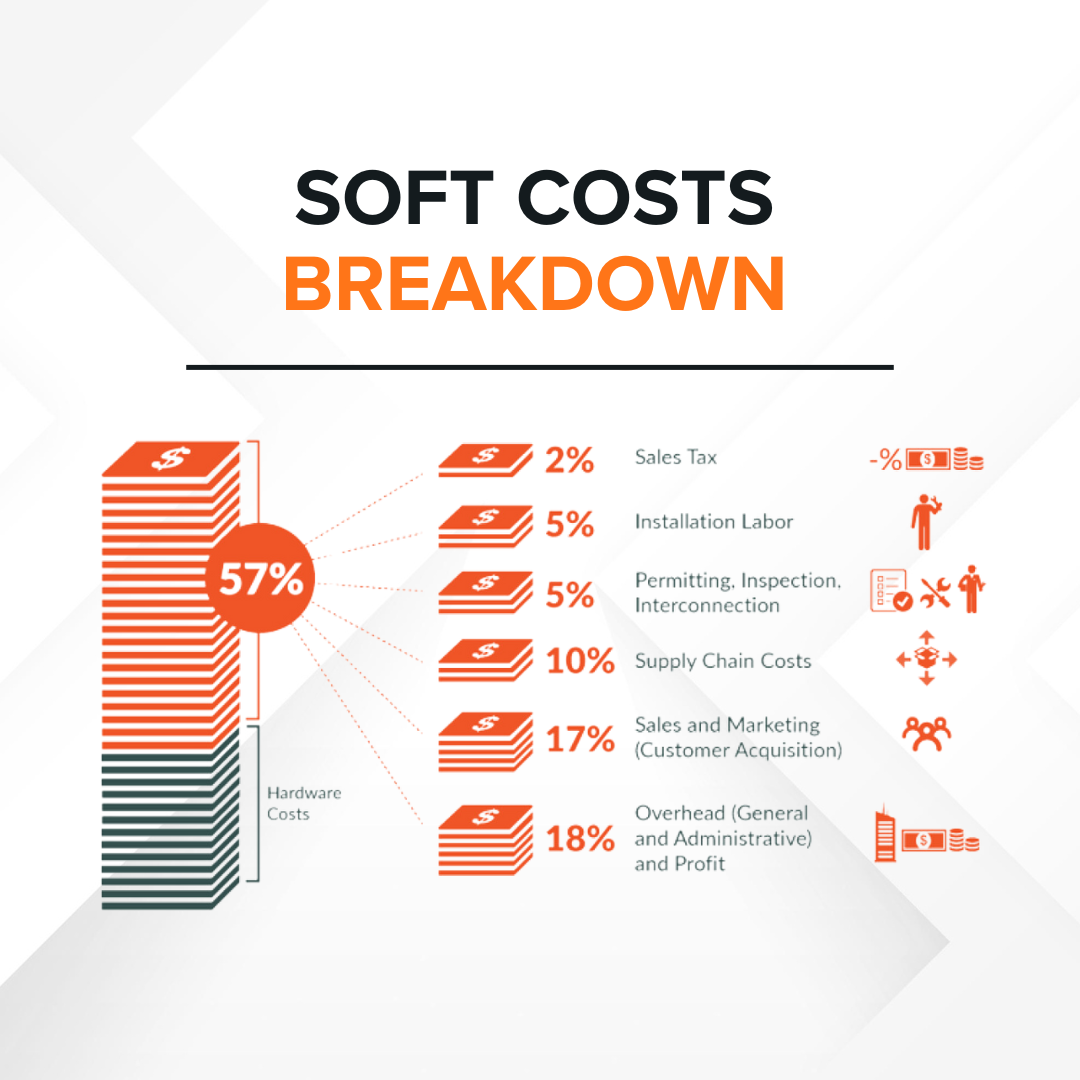
Soft costs are all the extra expenses in a solar project that have nothing to do with the actual equipment. Think of them as the behind-the-scenes costs that happen before, during, and after installation, things like permits, labor, marketing, and paperwork.
Even though solar panels are cheaper than ever, these soft costs still make up over half of the total price of going solar. Why? Getting a system from idea to installation takes time, approvals, coordination, and sales efforts, all of which cost money.
Here’s what soft costs include:
- Permitting & Paperwork – Getting approval before installation.
- Labor & Installation – Paying the crew that sets up the system.
- Sales & Marketing – Finding and converting customers.
- Proposal & Design Work – Creating customized system layouts and pricing.
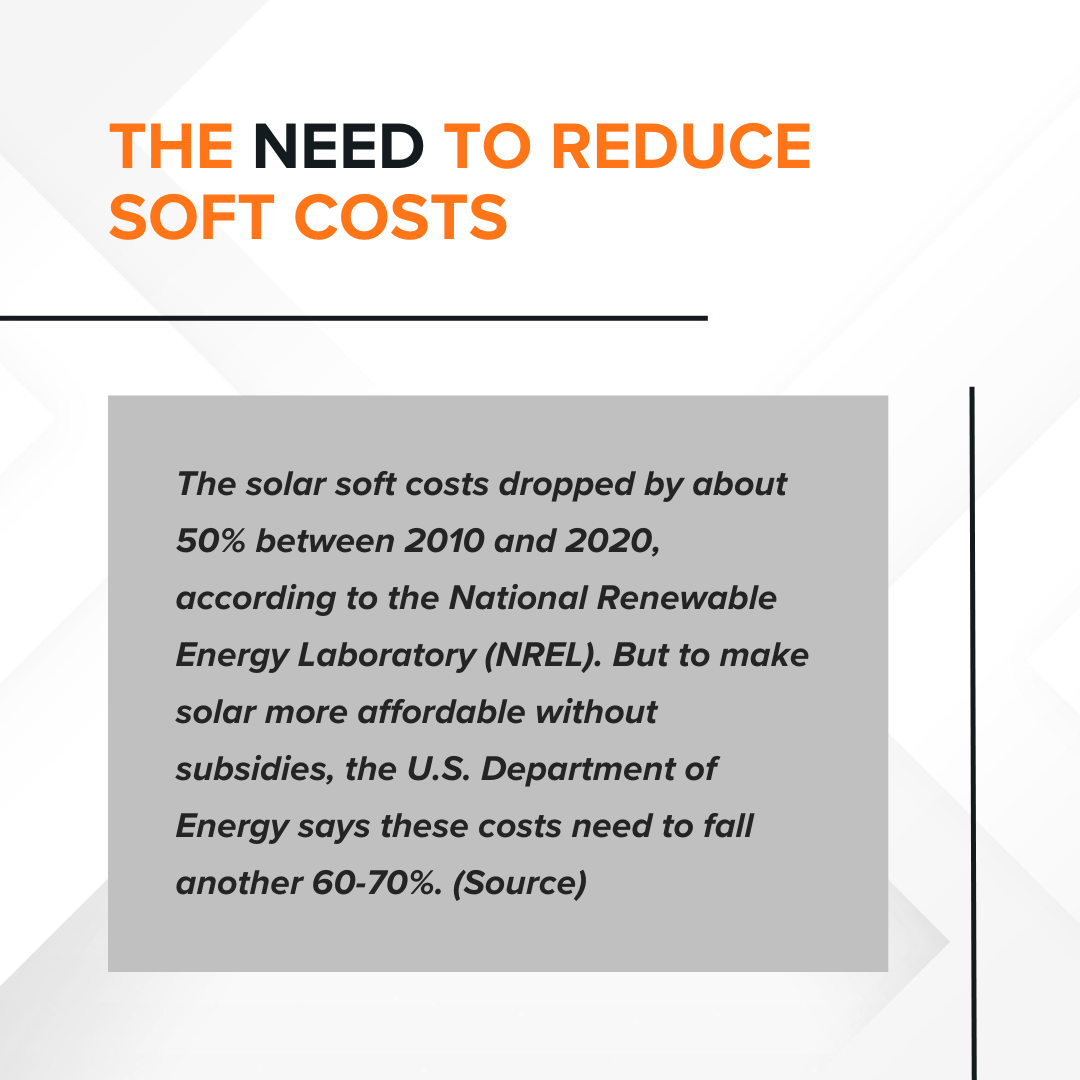
The Need to Reduce Soft Costs
The solar soft costs dropped by about 50% between 2010 and 2020, according to the National Renewable Energy Laboratory (NREL). But to make solar more affordable without subsidies, the U.S. Department of Energy says these costs need to fall another 60-70%. (Source)
The good news? With the right tools, such as automated proposals, AI-powered designs, and streamlined approvals, solar companies can significantly reduce soft costs, making solar more cost-effective for everyone.
Must Read: 10 Tips for Solar Professionals to Succeed in 2025
How Proposal & Design Inefficiencies Drive Up Soft Costs?
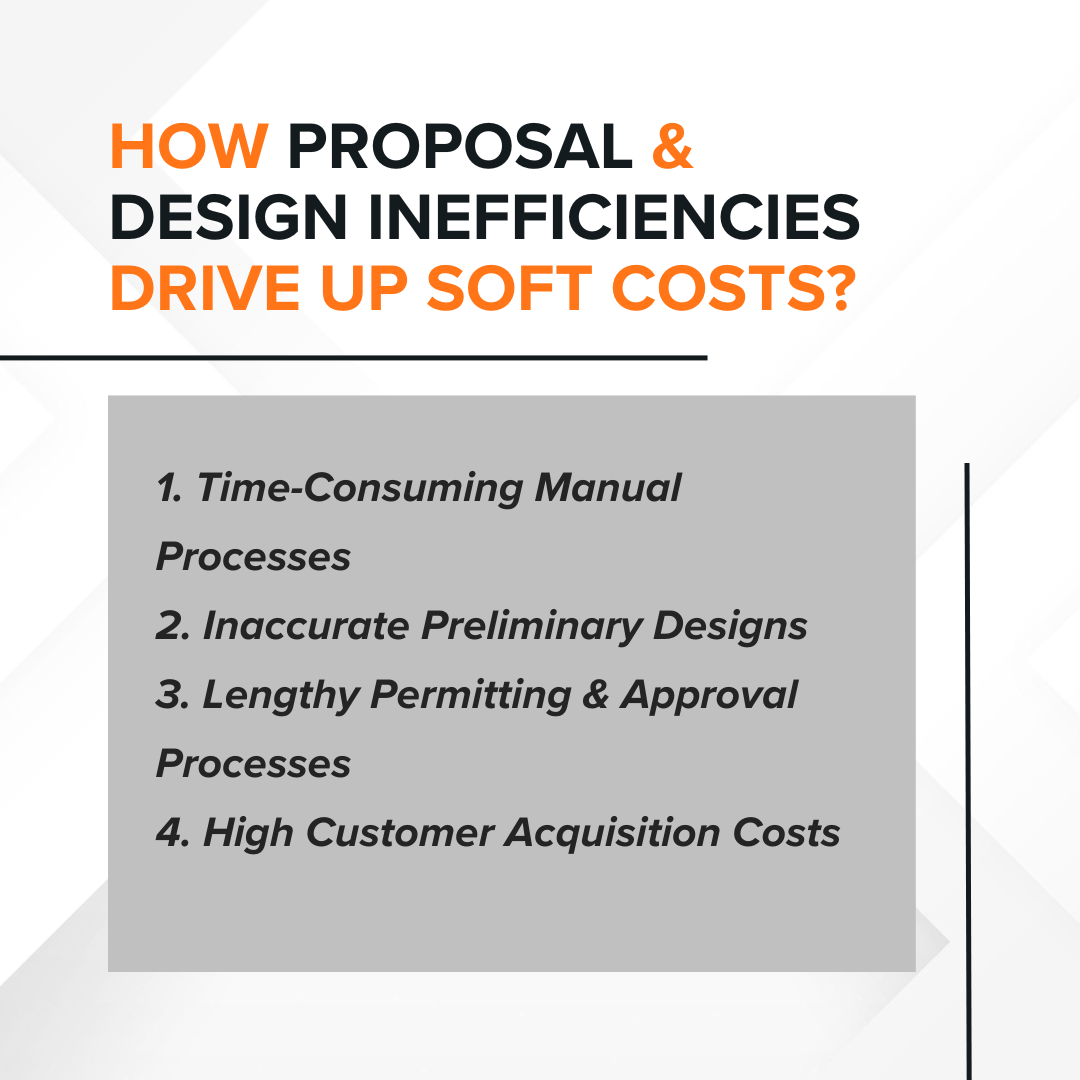
Soft costs in solar are a huge deal, and they make up a significant portion of the total project cost. And one of the biggest culprits? Inefficiencies in the proposal and design phase. When this stage is slow, messy, or inaccurate, costs start piling up fast.
Let’s break it down:
1. Time-Consuming Manual Processes
The problem? Creating proposals and designing solar layouts takes way too long when done manually.
What happens? Sales reps and engineers waste hours on something that could be done in minutes.
Why does it matter? Time is money; every extra hour spent on proposals means higher labor costs and slower sales.
2. Inaccurate Preliminary Designs
The problem? If the design isn’t right the first time, things go wrong later, such as wrong system size, shading issues, and installation surprises.
What happens? Midway through the project, you realize the system won’t fit, and now you need last-minute changes.
Why does it matter? Reworking designs cost thousands in labor and delays.
3. Lengthy Permitting & Approval Processes
The problem? If your designs aren’t accurate, standardized, or compliant, permitting becomes a nightmare.
What happens? Local authorities reject your plans, asking for changes and more paperwork.
Why does it matter? Every delay means higher costs and frustrated customers.
4. High Customer Acquisition Costs
The problem? A slow or complex proposal process turns customers away.
What happens? Homeowners get confused or frustrated and choose a competitor instead.
Why does it matter? Lower conversion rates mean you have to spend more on marketing and lead generation.
How Proposal Tools Cut Soft Costs?
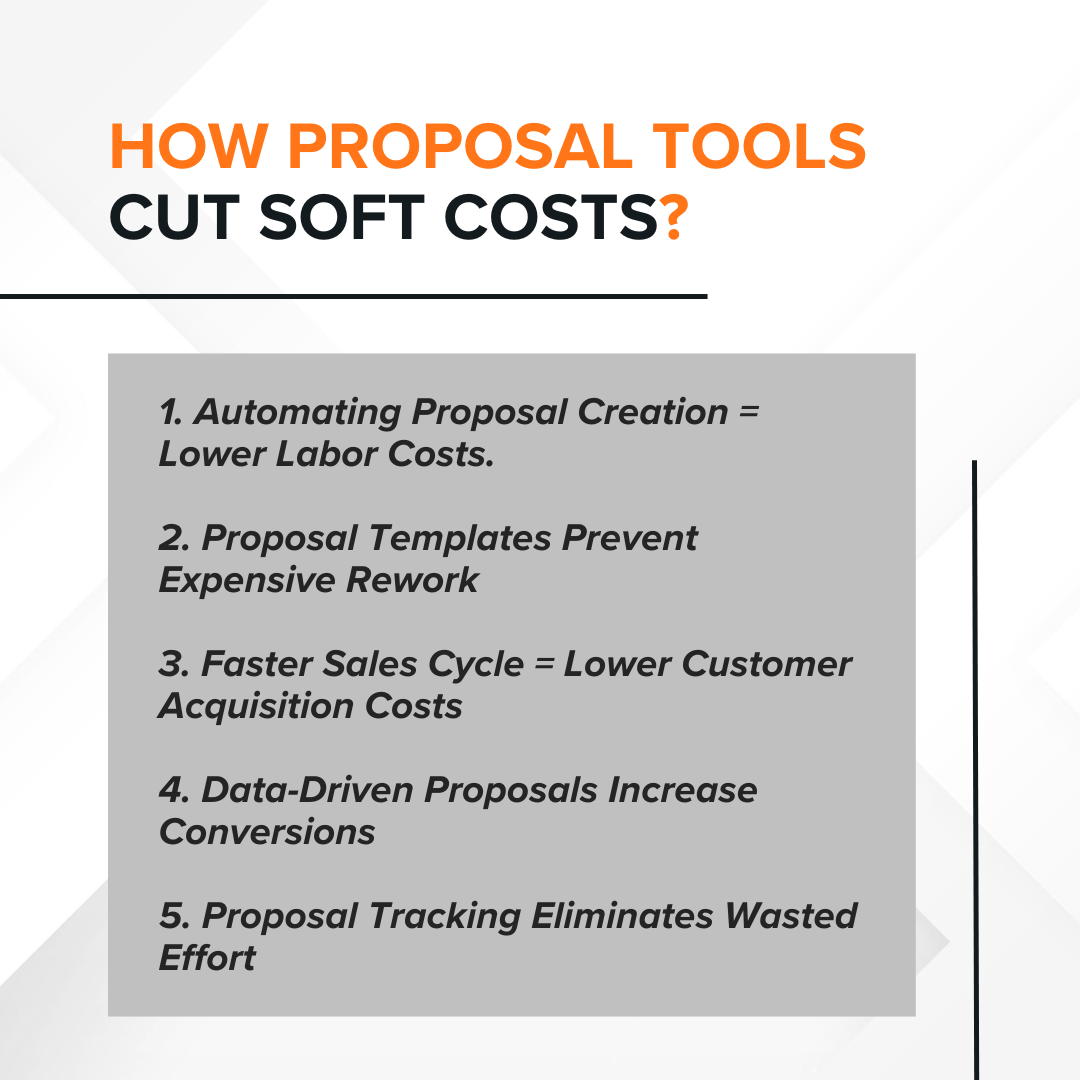
1. Automating Proposal Creation = Lower Labor Costs
Building a proposal manually takes time; gathering customer data, calculating system size, and estimating financials is a long process. But with proposal software, all of that happens automatically.
- Instant system sizing, energy production estimates, and financial breakdowns, no more manual calculations.
- Auto-filled proposal templates mean reps don’t start from scratch every time.
- Faster turnaround = less time spent on each deal = fewer labor hours = lower costs.
How this cuts soft costs: Instead of paying sales reps for hours of admin work, they spend that time actually selling. Less labor = lower expenses.
2. Proposal Templates Prevent Expensive Rework
Ever sent out a proposal only to realize later that key details were missing? That means extra emails, extra revisions, and wasted time. Proposal templates eliminate that issue.
- Pre-built, standardized formats ensure nothing gets left out.
- Consistent branding and pricing reduce mistakes that could lead to costly errors.
- Faster approvals when proposals are correct the first time, there’s no need for back-and-forth revisions.
How this cuts soft costs: Every unnecessary revision means paying your team for extra work. Proposal templates eliminate this waste.
3. Faster Sales Cycle = Lower Customer
Acquisition Costs
Speed matters. Customers don’t want to wait days for a proposal. They want to check out other options.
Proposal management software helps solar companies move quickly and lock in deals before the competition does.
- Personalized proposals are ready in minutes, not days.
- Professional proposals build confidence, making it easier for customers to say “ hell yes.”
- A shorter sales cycle = less money spent on follow-ups and lead nurturing.
How this cuts soft costs: The longer a deal drags on, the more it costs in follow-ups, marketing, and lost opportunities. A faster sales cycle keeps expenses low.
4. Data-Driven Proposals Increase Conversions
A well-structured business proposal isn’t just a formality; it’s what convinces customers to move forward. Proposal solutions provide clear, data-backed insights that help homeowners make decisions
quickly and confidently.
- Breaks down energy savings, financing options, and ROI in an easy-to-understand format
- Visually appealing, compelling proposals that make a strong impression.
- Higher close rates mean fewer leads are wasted.
How this cuts soft costs: More conversions = less money spent chasing new leads.
5. Proposal Tracking Eliminates Wasted Effort
Ever wonder if a customer even opened your proposal? Chasing unresponsive leads is a huge waste of time and money. With proposal tracking, sales teams focus only on high-intent buyers.
- When a proposal is opened, real-time notifications follow up at the right time.
- Insights on customer engagement help reps prioritize the most interested leads.
- Less wasted effort chasing cold leads, more time closing hot deals.
How this cuts soft costs: Sales teams spend their time where it actually matters, reducing wasted effort and labor.
Learn: Empowering Solar EPC Companies: The Key Features of Sunbase Solar Proposal Software
How Design Tools Cut Soft Costs in Solar Projects?
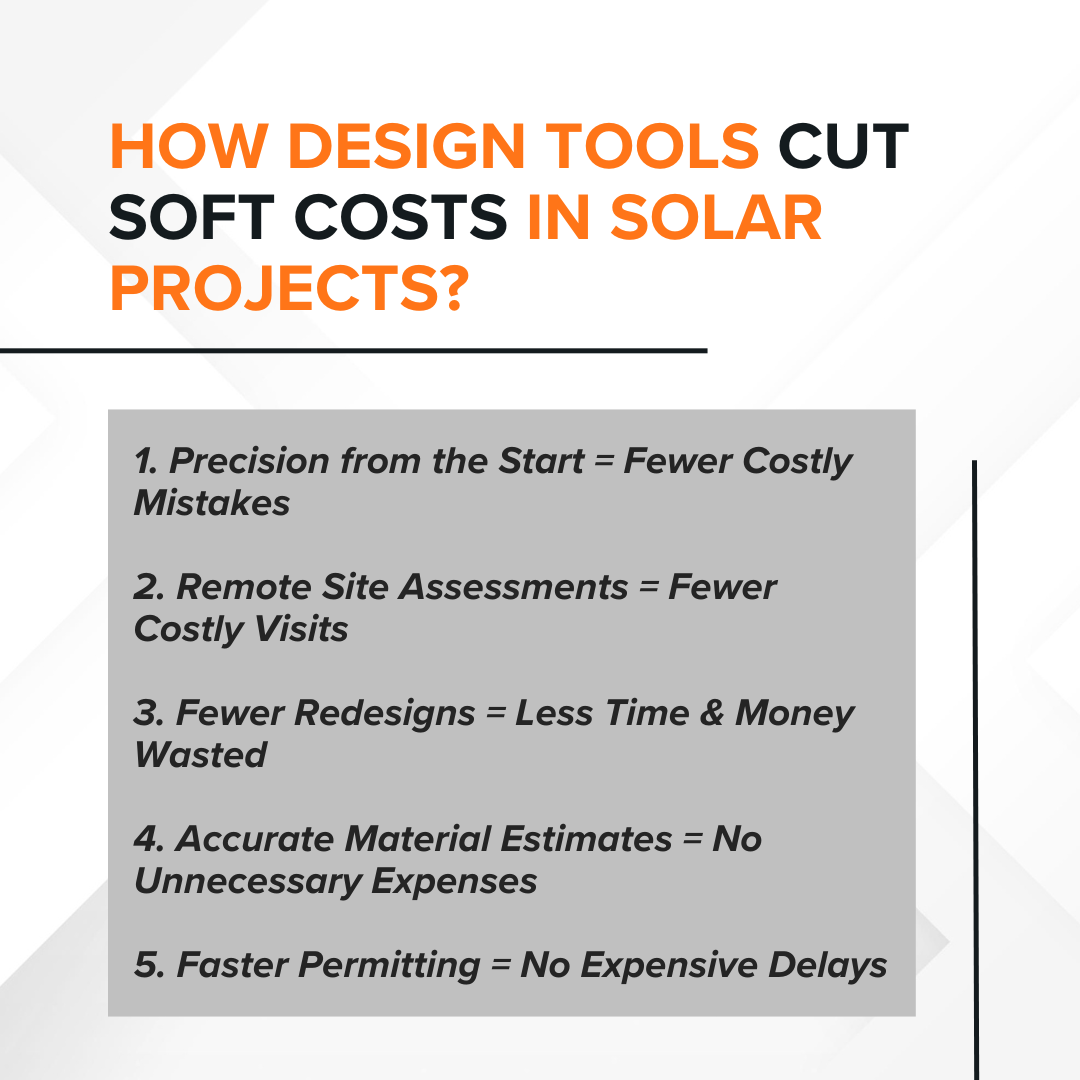
1. Precision from the Start = Fewer Costly Mistakes
A poorly designed system can lead to unexpected issues, panels that don’t fit, underperforming systems, or last-minute changes that slow everything down. Design software eliminates these risks.
- AI-powered tools figure out the best panel placement for maximum energy production.
- Shading analysis ensures no tree or chimney messes with performance.
- Auto-calculations ensure the system is perfectly sized for the customer’s energy needs.
How this cuts soft costs: If the design is spot-on from the start, there’s no need for expensive rework, extra labor, or project delays.
2. Remote Site Assessments = Fewer Costly Visits
Sending teams out for measurements before the deal is even closed? That’s an unnecessary expense. With solar design tools, remote site assessments replace costly in-person visits.
- High-resolution satellite imagery gives exact roof measurements without stepping on-site.
- 3D modeling tools simulate real-world conditions, ensuring a perfect system layout.
- Instant shading and tilt calculations mean no need for manual inspections.
How this cuts soft costs: Fewer site visits mean less travel time, lower labor costs, and faster project timelines.
3. Fewer Redesigns = Less Time & Money Wasted
One of the biggest soft-cost killers? Constantly tweaking designs because something was missing. Solar design software takes care of that.
- Make real-time adjustments, move panels, tweak placements, or change components in seconds.
- Instantly see energy production, costs, and potential issues; no surprises later.
- Designs are already permit-ready, so approvals happen faster.
How this cuts soft costs: Less back-and-forth, fewer delays, and lower labor costs.
4. Accurate Material Estimates = No Unnecessary Expenses
Overestimating materials? Wasted money. Underestimating? Expensive last-minute orders. Design tools eliminate the guesswork.
- Automatically calculates the exact number of panels, inverters, and mounting hardware.
- Prevents over-ordering, so there’s no wasted inventory.
- Avoids under-ordering, meaning no emergency rush orders.
How this cuts soft costs: Accurate material planning means no extra spending.
5. Faster Permitting = No Expensive Delays
Permitting can slow projects down, and every delay costs money, whether it’s paying workers for standby time or losing customers due to frustration. Solar design tools help speed up approvals.
- Auto-rated permit packages include all necessary technical details.
- Pre-approved design templates ensure compliance with local codes.
- Fewer errors mean fewer rejected applications and faster approvals.
How this cuts soft costs: Faster permits mean projects start sooner, reducing holding costs and preventing lost revenue.
For better understanding: Optimizing Solar EPC Operations: How Design Software Improves Accuracy and Reduces Rework
Sunbase – The #1 Solution for Lower Soft Costs & Higher Profits

Are soft costs slowing you down?
Sunbase’s proposal and design tools are built to streamline your sales process, eliminate inefficiencies, and maximize profitability.
From fast, automated proposals to AI-powered designs, Sunbase can help you close deals quicker and cut unnecessary costs.
Let's see how:
The Best Proposal Software – Faster Sales, Lower Costs
Automated Proposals
No more manual number-crunching. Just enter the kWh usage, and Sunbase calculates everything throughout the proposal creation process, saving time and labor costs.
Data-Driven Proposals
Impress customers with accurate savings estimates, financing options, and ROI breakdowns, eliminating time-consuming manual calculations and reducing labor costs
Professional Proposals with E-Signatures
Custom templates and e-signatures speed up approvals, reducing back-and-forth and administrative delays.
Check out: Manual vs. Automated Proposal Management: Which One Saves You More Money?
Intelligent Design Software – Smarter Planning, Fewer Expenses
Accurate 3D Modeling
Create AI-powered layouts remotely using aerial imagery, eliminating the need for on-site assessments and cutting travel expenses.
Remote Site Evaluation
Satellite imagery replaces in-person measurements, eliminating unnecessary trip and travel costs.
Code-Compliant Designs for Faster Permits
Plans align with local regulations upfront, preventing rejections and costly resubmissions.
Go Through: Top 5 Benefits of Implementing Solar Design Software
Here's proof that Sunbase is the best choice for reducing soft costs. Now, it's up to you to decide.
Conclusion
Soft costs might be sneaky, but they don’t stand a chance against the right tools. When project timelines are streamlined, administrative tasks are automated, and coordination is seamless, solar companies cut down on labor costs, inefficiencies, and unexpected delays. And let’s be honest, who doesn’t want that?
Sunbase is the key to reducing bottlenecks, minimizing design revisions, and speeding up approvals, all of which drive down soft costs.
Plus, a dedicated customer success team ensures everything runs smoothly, so you are never left to figure it out alone. So, the real question is: Why continue dealing with unnecessary expenses when there’s a smarter way?
About Sunbase
With Sunbase’s proposal and design tools, solar companies reduce soft costs, close deals faster, and streamline operations like never before. Why waste time and money when there’s a better way? Join the solar companies that are already maximizing profits with Sunbase. Contact us
Frequently Asked Questions
Q1. How does better collaboration between sales teams and designers reduce unnecessary expenses?
Ans. Collaboration tools ensure seamless communication between sales reps and designers, reducing costly revisions, misaligned expectations, and time-consuming back-and-forth adjustments.
Q2. Can an inefficient proposal process lead to lost revenue?
Ans. Yes! Potential customers lose interest or move to competitors when proposals are slow or inconsistent. Sales teams waste time fixing errors instead of closing deals. Sunbase optimizes proposal efforts, reducing turnaround time and increasing conversions, leading to higher revenue and lower soft costs.
Q3. Why Shouldn’t Sales Teams Rely on Free Proposal Software to Reduce Soft Costs?
Ans. Free proposal software solutions may seem like a good option, but they often lack automation, accuracy, and customization, making proposals harder and leading to costly mistakes. Without the best proposal tools, sales teams waste time fixing errors and dealing with delays. Sunbase solves this by automating proposals, ensuring accuracy, and speeding up approvals so teams can close deals faster and cut costs.
Q4. How does better design software turn complex solar projects into faster sales and lower costs?
Ans. Design software simplifies complex solar projects by generating precise system layouts quickly, minimizing errors, and reducing manual adjustments. Integrating real-time shading analysis, energy production estimates, and seamless proposal creation cuts down on delays, accelerates approvals, and lets sales teams close deals faster, lower soft costs, and be more efficient.
I agree to receive marketing messaging from Sunbase at the phone number provided above. I understand data rates will apply, and can reply STOP to OPT OUT.
Company
Industries
Features
Copyright ©2021
Terms of Service |
Privacy Policy







